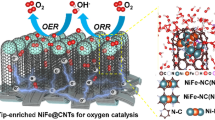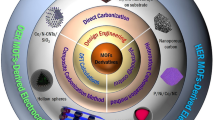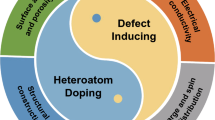Abstract
In this work, the excess water-stagnation issue in the high current region in direct methanol fuel cells (DMFCs) is resolved by using atomic precision modulated nitrogen-crafted graphene (NG) in the cathode microporous layer by utilizing simplistic, industrial-expansive and ecological strategy. Few-layer 2D-graphene (∼2–5 nm thickness) is prepared by bath sonication approach from abundant feedstock-graphite and is treated with nitric acid to yield 1.8 wt.% uniformly dispersed nitrogen containing NG. Specifically, 1:4 weight ratio NG:carbon-black (CB) hybrid architecture, displays 0.252 V in 370 mA cm−2 with the peak power density of 93.4 mW cm−2, improving cell power density by 45.6% compared with standard one at 60°C and 1 mol/L methanol/oxygen conditions at ultra-low catalyst loadings and displaying exceptional stability. Atomic insights into NG reveal that interplay between bonding configurations, altered hydrophobic/hydrophilic porosity of graphene (10.6% less wettability from contact angle and 13.1% high electrode porosity measurements) contribute to the better mass-transport-porogenic effect (16.3% high oxygen-permeability), mildly affecting the electron pathway (6.5% reduced in-plane electrical conductivity), overall significantly improving cell performance. Altogether, this work delivers multiple advantages, i.e., the usage of material from facile, sustainable and cost-effective routes, while improving DMFC performance with potential industrial promise.
Similar content being viewed by others
References
Dicks A, Rand D. Fuel Cell Systems Explained. Hoboken: Wiley, 2018
O’Hayre R. Fuel Cell Fundamentals. Hoboken: John Wiley & Sons, 2005
Lin C, Wang T, Ye F, et al. Effects of microporous layer preparation on the performance of a direct methanol fuel cell. Electrochem Commun, 2008, 10: 255–258
Weber A Z, Newman J. Effects of microporous layers in polymer electrolyte fuel cells. J Electrochem Soc, 2005, 152: A677
Rho Y W, Srinivasan S, Kho Y T. Mass transport phenomena in proton exchange membrane fuel cells using O2/He, O2/Ar, and O2/N2 mixtures: II. theoretical analysis. J Electrochem Soc, 1994, 141: 2089–2096
Lin J H, Chen W H, Su Y J, et al. Effect of gas diffusion layer compression on the performance in a proton exchange membrane fuel cell. Fuel, 2008, 87: 2420–2424
Antolini E, Passos R R, Ticianelli E A. Effects of the carbon powder characteristics in the cathode gas diffusion layer on the performance of polymer electrolyte fuel cells. J Power Sources, 2002, 109: 477–482
Hiramitsu Y, Sato H, Hori M. Prevention of the water flooding by micronizing the pore structure of gas diffusion layer for polymer electrolyte fuel cell. J Power Sources, 2010, 195: 5543–5549
Hwang C M, Ishida M, Ito H, et al. Influence of properties of gas diffusion layers on the performance of polymer electrolyte-based unitized reversible fuel cells. Int J Hydrogen Energy, 2011, 36: 1740–1753
Velayutham G, Kaushik J, Rajalakshmi N, et al. Effect of PTFE content in gas diffusion media and microlayer on the performance of PEMFC tested under ambient pressure. Fuel Cells, 2007, 7: 314–318
Liu S, Wippermann K, Lehnert W. Mechanism of action of polytetrafluoroethylene binder on the performance and durability of high-temperature polymer electrolyte fuel cells. Int J Hydrogen Energy, 2021, 46: 14687–14698
Gharibi H, Javaheri M, Mirzaie R A. The synergy between multi-wall carbon nanotubes and Vulcan XC72R in microporous layers. Int J Hydrogen Energy, 2010, 35: 9241–9251
Gallo Stampino P, Omati L, Cristiani C, et al. Characterisation of nanocarbon-based gas diffusion media by electrochemical impedance spectroscopy. Fuel Cells, 2010, 10: 270–277
Bottino A, Capannelli G, Comite A, et al. Microporous layers based on poly(vinylidene fluoride) and sulfonated poly(vinylidene fluoride). Int J Hydrogen Energy, 2015, 40: 14690–14698
Wang X L, Zhang H M, Zhang J L, et al. Micro-porous layer with composite carbon black for PEM fuel cells. Electrochim Acta, 2006, 51: 4909–49 15
Cindrella L, Kannan A M, Ahmad R, et al. Surface modification of gas diffusion layers by inorganic nanomaterials for performance enhancement of proton exchange membrane fuel cells at low RH conditions. Int J Hydrogen Energy, 2009, 34: 6377–6383
Wang Y, Al Shakhshir S, Li X. Development and impact of sandwich wettability structure for gas distribution media on PEM fuel cell performance. Appl Energy, 2011, 88: 2168–2175
Kitahara T, Nakajima H, Mori K. Hydrophilic and hydrophobic double microporous layer coated gas diffusion layer for enhancing performance of polymer electrolyte fuel cells under no-humidification at the cathode. J Power Sources, 2012, 199: 29–36
Geim A K. The rise and rise of graphene. Nature Nanotech, 2010, 5: 755
Balakrishnan P, Holmes S. 2D materials graphene and hBN boost DMFC performance. Fuel Cells Bull, 2017, 2017(4): 14
Han T, Luo Y, Wang C. Effects of SI, N and B doping on the mechanical properties of graphene sheets. Acta Mech Solid Sin, 2015, 28: 618–625
Yuan T, Yang J, Wang Y, et al. Anodic diffusion layer with graphene-carbon nanotubes composite material for passive direct methanol fuel cell. Electrochim Acta, 2014, 147: 265–270
Leeuwner M J, Wilkinson D P, Gyenge E L. Novel graphene foam microporous layers for PEM fuel cells: Interfacial characteristics and comparative performance. Fuel Cells, 2015, 15: 790–801
Najafabadi A T, Leeuwner M J, Wilkinson D P, et al. Electrochemically produced graphene for microporous layers in fuel cells. ChemSusChem, 2016, 9: 1689–1697
Ozden A, Shahgaldi S, Li X, et al. A graphene-based microporous layer for proton exchange membrane fuel cells: Characterization and performance comparison. Renew Energy, 2018, 126: 485–494
Leeuwner M J, Patra A, Wilkinson D P, et al. Graphene and reduced graphene oxide based microporous layers for high-performance proton-exchange membrane fuel cells under varied humidity operation. J Power Sources, 2019, 423: 192–202
Shavelkina M B, Kleimenov B V, Zhuk A Z, et al. Gas diffusion layers based on graphene flakes doped with nitrogen. J Phys-Conf Ser, 2019, 1281: 012072
Gallo Stampino P, Latorrata S, Molina D, et al. Investigation of hydrophobic treatments with perfluoropolyether derivatives of gas diffusion layers by electrochemical impedance spectroscopy in PEM-FC. Solid State Ion, 2012, 216: 100–104
Yu J, Islam M N, Matsuura T, et al. Improving the performance of a PEMFC with ketjenblack EC-600JD carbon black as the material of the microporous layer. Electrochem Solid-State Lett, 2005, 8: A320
Yong V, Hahn H T. Graphene growth with giant domains using chemical vapor deposition. CrystEngComm, 2011, 13: 6933
Bautista-Flores C, Sato-Berrú R Y, Mendoza D. Doping graphene by chemical treatments using acid and basic substances. J Mater Sci Chem Eng, 2015, 03: 17–21
Breitwieser M, Bayer T, Büchler A, et al. A fully spray-coated fuel cell membrane electrode assembly using Aquivion ionomer with a graphene oxide/cerium oxide interlayer. J Power Sources, 2017, 351: 145–150
Durge R, Kshirsagar R V, Tambe P. Effect of sonication energy on the yield of graphene nanosheets by liquid-phase exfoliation of graphite. Procedia Eng, 2014, 97: 1457–1465
Amiri A, Naraghi M, Ahmadi G, et al. A review on liquid-phase exfoliation for scalable production of pure graphene, wrinkled, crumpled and functionalized graphene and challenges. FlatChem, 2018, 8: 40–71
Balakrishnan P, Sanij F D, Chang Z, et al. Nano-graphene layer from facile, scalable and eco-friendly liquid phase exfoliation strategy as effective barrier layer for high-performance and durable direct liquid alcohol fuel cells. Molecules, 2022, 27: 3044
Compton O C, Nguyen S B T. Graphene oxide, highly reduced graphene oxide, and graphene: Versatile building blocks for carbon-based materials. Small, 2010, 6: 711–723
Wang X, Sun G, Routh P, et al. Heteroatom-doped graphene materials: Syntheses, properties and applications. Chem Soc Rev, 2014, 43: 7067–7098
Wang P, Zhang C. Doped ways of boron and nitrogen doped carbon nanotubes: A theoretical investigation. J Mol Structure-THEOCHEM, 2010, 955: 84–90
Ferraro J, Nakamoto K. Introductory Raman Spectroscopy. Amsterdam: Elsevier Science, 2012
Casiraghi C, Pisana S, Novoselov K S, et al. Raman fingerprint of charged impurities in graphene. Appl Phys Lett, 2007, 91: 233108
D’Arsié L, Esconjauregui S, Weatherup R S, et al. Stable, efficient P-type doping of graphene by nitric acid. RSC Adv, 2016, 6: 113185–113192
Tien H N, Kocabas C, Hur S H. One-step codoping of reduced graphene oxide using Boric and nitric acid mixture and its use in metalfree electrocatalyst. Mater Lett, 2015, 143: 205–208
Lee H J, Kim E, Park J, et al. Radio-frequency characteristics of graphene monolayer via nitric acid doping. Carbon, 2014, 78: 532–539
Coleman J N. Liquid exfoliation of defect-free graphene. Acc Chem Res, 2013, 46: 14–22
Balakrishnan P. Engineering the membrane electrode assembly of direct methanol fuel cells using novel graphene architecture. Dissertation for Doctoral Degree. Manchester: University of Manchester, 2018
Yang C, Hu M, Wang C, et al. A three-step activation method for proton exchange membrane fuel cells. J Power Sources, 2012, 197: 180–185
Awada H, Castelein G, Brogly M. Quantitative determination of surface energy using atomic force microscopy: The case of hydrophobic/hydrophobic contact and hydrophilic/hydrophilic contact. Surf Interface Anal, 2005, 37: 755–764
Yan X H, Zhao T S, An L, et al. A crack-free and super-hydrophobic cathode micro-porous layer for direct methanol fuel cells. Appl Energy, 2015, 138: 331–336
Bhaskar A, Banerjee R, Kharul U. ZIF-8@PBI-BuI composite membranes: Elegant effects of PBI structural variations on gas permeation performance. J Mater Chem A, 2014, 2: 12962
Bevers D, Rogers R, von Bradke M. Examination of the influence of PTFE coating on the properties of carbon paper in polymer electrolyte fuel cells. J Power Sources, 1996, 63: 193–201
Author information
Authors and Affiliations
Corresponding authors
Additional information
This work was supported by China Postdoctoral Science Foundation (Grant No. 2019M661749), Six-Talent-Peaks Project in Jiangsu Province (Grant No. 2016-XNY-015), the High-Tech Key Laboratory of Zhenjiang City (Grant No. SS2018002), and Priority Academic Program Development (PAPD) of Jiangsu Higher Education Institutions.
Rights and permissions
About this article
Cite this article
Balakrishnan, P., Guan, L., Liu, H. et al. Tunable nitrogen crafted 2D-graphene nano-hybrid from industrial expansive and ecological approach as robust cathode microporous layer to improve performance of a direct methanol fuel cell. Sci. China Technol. Sci. 66, 2669–2680 (2023). https://doi.org/10.1007/s11431-022-2355-9
Received:
Accepted:
Published:
Issue Date:
DOI: https://doi.org/10.1007/s11431-022-2355-9




